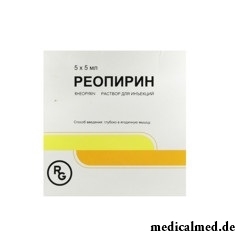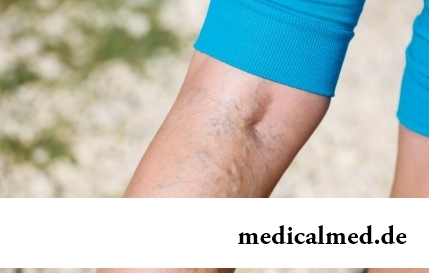





Rheopyrinum
Application instruction:
 Rheopyrinum – the combined medicine of antiinflammatory, analgeziruyushchy and febrifugal action.
Rheopyrinum – the combined medicine of antiinflammatory, analgeziruyushchy and febrifugal action.
Form of release and structure
Rheopyrinum is issued in the following forms:
- Dragee (on 10 pieces in the blister, in a cardboard pack two blisters);
- Solution for injections (on 5 ml in an ampoule, in a cardboard pack five ampoules).
Active ingredients as a part of 1 dragee:
- Sodium phenylbutazone – 125 mg;
- Aminophenazonum – 125 mg.
Active ingredients as a part of 1 ml of solution:
- Sodium phenylbutazone – 150 mg;
- Aminophenazonum – 150 mg.
Indications to use
- Polyneuritis, neuralgia, neuritis;
- Retinitis, iritis, iridocyclitis;
- Parametritis;
- Lumbago;
- Adnexitis;
- Polyserositis, pericardis (at severe pain);
- Diseases of soft extraarticular tissues and backbone with pains and the expressed inflammation;
- Noninfectious arthritises of various origin (including gouty arthritis and acute rheumatic arthritis).
Contraindications
- Chronic cardiomyopathy;
- Disturbances of a heart rhythm;
- Edematous syndrome (including in the anamnesis);
- Heart diseases;
- Peptic ulcer of a duodenum and stomach;
- Diseases of bodies of system of a hemopoiesis;
- Diseases of kidneys and liver;
- Children's age up to 7 years;
- Hypersensitivity to drug.
Route of administration and dosage
At rheumatic diseases Rheopyrinum is accepted inside in a dose of 4-6 dragees in days or deeply intramusculary 5 ml a day every day or every other day (solution is entered slowly (within 1-2 minutes) into a gluteus by means of a long needle).
At a parametritis and an adnexitis the drug is administered intramusculary on 5 ml by each 4-5 days before disappearance of symptoms.
For children aged from 7 up to 14 years the recommended dose of Rheopyrinum makes 0,5-1 dragees or 0,5-1 ml of solution 3 times a day every day or every other day.
Side effects
- Alimentary system: perhaps – vomiting, nausea, increase of a chair, erosive cankers of digestive tract, pain in epigastriums;
- Cardiovascular system: tachycardia;
- Central nervous system: drowsiness, dizziness;
- Urinary system: a hamaturia, a glucosuria, a renal tubular necrosis (at prolonged treatment in high doses);
- Metabolism: delay of sodium and water;
- System of a hemopoiesis: seldom – anemia, thrombocytopenia, a leukopenia; at prolonged treatment by high doses of drug – an agranulocytosis;
- Allergic reactions: urticaria, itch, skin rash;
- Local reactions: pain in the place of an injection, sterile abscess in an injection site.
Special instructions
To children Rheopyrinum is appointed in exceptional cases, in the conditions of a hospital and only under control of the doctor and at regular tracking of a picture of peripheral blood, function of a liver and composition of urine.
In case of suspicion of epilepsy parenteral administration of Rheopyrinum is not recommended.
At prolonged use it is necessary to control number of leukocytes every week.
Medicinal interaction
At simultaneous use drug weakens action of Phenytoinum, cephalosporins, Imipraminum and griseofulvin.
Rheopyrinum strengthens effect of anticoagulants, barbiturates, streptocides and peroral hypoglycemic means.
Terms and storage conditions
To store at a temperature of 15-25 °C. To protect from children. A period of validity – 3 years.
The liver is the heaviest body in our body. Its average weight makes 1,5 kg.

Life activity of one-celled fungi of the sort Candida is a proximate cause of development of candidiasis (milkwoman), it is related...
Section: Articles about health
Separate food - the system of meal based on digestion physiology which is carried to improvement methods. According to nutritionists, the separate use of the carbohydrate and proteinaceous products demanding different conditions of assimilation helps to get rid from Bol...
Section: Articles about health
Work of a brain is extremely complex and in many respects is not studied yet. It is confirmed also by the features of thought processes which are shown when the person sleeps. Let's tell about some of them....
Section: Articles about health
Each person supports all life a SARS about 200 times. The peak of incidence falls on cold season, but to get sick from temperatures...
Section: Articles about health
The advantage of swimming for the person is so high that this sport is not only the most popular, but also is widely applied in medicine and rehabilitation processes. If you look for for yourself the occupation allowing pleasantly and to spend time, then swimming with advantage...
Section: Slideshow
Iodine - one of thirty most important microelements in our organism. The main role of iodine consists in synthesis of thyroid hormones of a thyroid gland - the substances which are responsible for the majority of exchange processes of an organism. It is known that thyroid hormones consist of iodine more than for 65%. The lack of iodine leads to decrease in production of hormones and, as a result, development of a hypothyroidism. The long condition of deficit can become a source of problems of the cardiovascular, bone, digestive SI...
Section: Articles about health
Beauty shop – the place which is associated only with positive emotions: joy, pleasure, relaxation. One...
Section: Articles about health
Coffee - the tonic loved by many for the invigorating aroma and deep taste. Having the stimulating effect, coffee increases working capacity, promotes concentration of attention, fights against drowsiness and improves mood. Statistically, about 30% of inhabitants...
Section: Articles about health
The immunity role in growth of the child is invaluable. The proteins-immunoglobulins produced by immune system preserve the child against the diseases capable − owing to an organism weak still − to serve as a stressful factor, to become the reason of many complications and delays in development of the kid. If the immune system weakened, health of the child is under direct threat and needs active actions for strengthening of protective forces of an organism − preferably non-drug....
Section: Articles about health
For many women the word "fat" sounds as a sentence. In aspiration to an ideal figure they try to exclude, first of all, from with...
Section: Articles about health
The kid who was recently born is surrounded with love of adult family members and their cares without which the baby cannot exist. Some parents consider that gentle attachment and caress are quite enough that the child correctly developed and was happy...
Section: Articles about health
Extracorporal fertilization – one of the most modern methods of controlling with infertility. So far he already helped a significant amount of married couples to become happy parents. Usually to the EKO procedure difficult and very expensive, resort in those situations when all other ways to help couple to bring the child are inefficient. "Conception in a test tube" yields quite good results in cases of infertility of one of partners, existence at the woman of impassability of uterine tubes...
Section: Articles about health
Almost each of us during life faced dissatisfaction with own body. At such moments, as a rule, we beginning...
Section: Articles about health
The modern person not always manages to find housing in the environmentally friendly region and such work which would not do harm to health. With food stuffs at first sight the situation is much better: shops are overflowed with goods which are positioned пр...
Section: Articles about health
From the failure of work of immune system which is shown in the form of an allergy, statistically, more than 40% of the population of the globe suffer. In most cases pathological reactions cause the substances which are contained in food stuffs, hair of animals, medicines, goods of household chemicals, cosmetics, pollen of plants, etc. On the one hand, the disease such is capable to spoil quite thoroughly to the person life....
Section: Articles about health
Practically each person is familiar with the annoying, pulling, unscrewing pains caused by overcooling of muscles of a back. In некото...
Section: Articles about health
Scientists always aimed to offer fundamental explanations for medical problems. Their theories formed the basis of modern methods of treatment of the hardest pathologies and helped to save a set of lives. However stories are known also such theoretical constructions, following to...
Section: Articles about health
For many spouses the question of planning of a family is one of the main. The problem of the choice of effective and safe contraceptives at the same time comes out on top. Russians still not often resort to operation of a vasectomy extremely popular in the USA, and also in some European and Asian countries. The reason is simple: most of men simply do not possess the complete information about specifics and effects of this procedure. Let's try to meet this lack and to acquaint readers about those...
Section: Articles about health
We live during an advertizing era. Daily each person receives a solid portion of persuasive councils about what to eat to be здо...
Section: Articles about health
Tuberculosis – a serious infectious disease which development is caused by mycobacteria (Koch's bacilli). The illness is known from an extreme antiquity. Long time fight against it was considered as ineffective. Quite often the disease affected the whole families, and mortality from it was very much...
Section: Articles about health
Subfebrile temperature call fervescence to 38 degrees, and subfebrile condition - existence of such temperature over 3 days, and quite often it happens without the visible reasons. Existence of subfebrile condition - a strong indication of disturbances in an organism which can be caused by various reasons: disease, stresses, hormonal failures. Despite the seeming inoffensiveness it is a state at which people often continue to lead a usual life, often is a sign of many of a zabolev...
Section: Articles about health
Aspirin (acetylsalicylic acid) – one of those drugs which are known literally to all. It is available in each home first-aid kit...
Section: Articles about health
The varicosity has familiarly many, statistically, this disease more than a half of all adult population. As a rule, the varicosis affects preferential superficial vessels, and is shown by characteristic cosmetic defects. Guo...
Section: Articles about health
The phenomenon of improvement of a condition of the patients at administration of drugs who are not containing active agents, so-called effect of placebo is known long ago. At the end of the 18th century the American doctor Perkins began to treat people the "miracle" sticks made of alloy of steel and brass. Was for several minutes to press such subject enough to a sore point that it became much easier for the patient. Having suspected Perkins of charlatanism, his colleagues tried to repeat "miracle" by means of sticks, steles...
Section: Articles about health
Each failure in work of bodies and systems of a human body is, as a rule, shown by the whole complex of symptoms. In particular, N...
Section: Articles about health
In consciousness of our many compatriots idea that folk remedies if are no more effective, than medicinal "chemistry" strongly took roots, then are precisely less harmful. Unfortunately, it is not always fair: some receptions treating...
Section: Articles about health
80% of women at least once to lives complained of discomfortable feelings to breasts, consolidations and nagrubaniye. These are mastopathy symptoms. The mastopathy is characterized by change of a ratio between ferruterous and connective tissue tissues of mammary glands. It can lead to formation of cysts (a cystous mastopathy), gland consolidation (a fibrous mastopathy), or a combination of these processes (a fibrous and cystous mastopathy)....
Section: Articles about health
